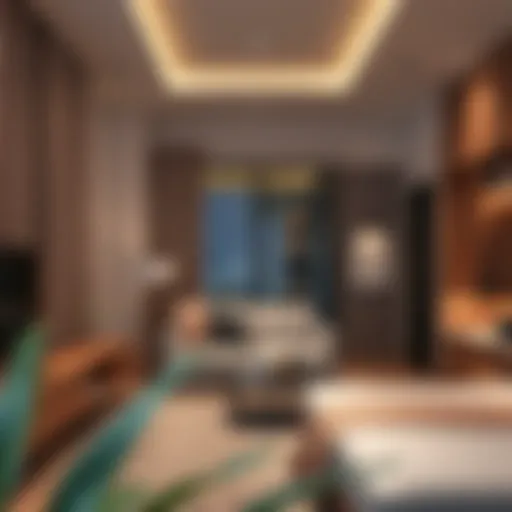Tall Buildings of Dubai: An In-Depth Overview
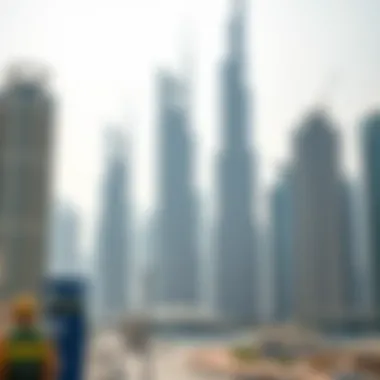
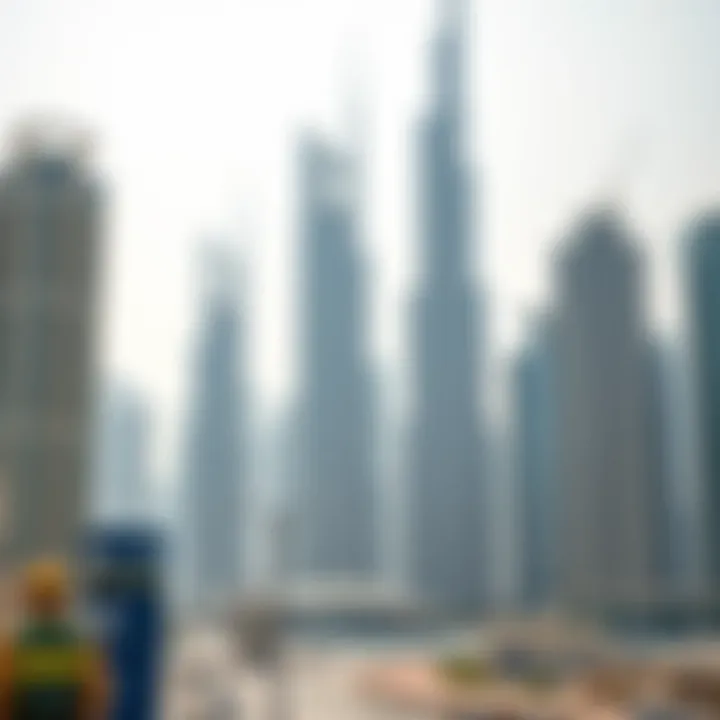
Intro
Dubai's towering skyline isn't just a sight to see; it represents the heart of a city where ambition meets innovation. Home to some of the world's tallest and most architecturally stunning buildings, Dubai has made a name for itself globally, drawing tourists and investors alike. The city's unique approach to real estate blends modern design with cultural identity, creating structures that are not simply buildings but landmarks that tell a story.
This exploration dives into the architecture, design philosophies, and the impacts of these skyscrapers on Dubai’s economy and real estate market. With a growing interest from buyers, understanding these tall buildings and their significance can provide invaluable insight for potential investors. By deciphering the intricacies of Dubai’s real estate landscape, this article aims to navigate the bustling market while highlighting the importance of these architectural wonders in shaping not only the city's skyline but also its identity and economic growth.
Foreword to Dubai's Skyscraper Landscape
Dubai has gained a reputation as a hub for architectural innovation and urban development, primarily through its stunning lineup of skyscrapers. These towering structures are not merely buildings; they are symbols of ambition, progress, and the relentless pursuit of excellence. The importance of understanding Dubai's skyscraper landscape goes beyond aesthetics; it delves into how these structures reflect the city's identity, cultural aspirations, and economic strategies.
As we explore Dubai's skyline, which has rapidly evolved, we find that the city's skyscrapers are indicative of both historical and contemporary narratives. Each building tells a story of growth, determination, and dreams reaching for the sky, literally and metaphorically. Investors, homeowners, and city planners must comprehend the nuances of this landscape, especially as it relates to property values, tourism revenue, and community dynamics.
Historical Context of Skyscrapers in Dubai
When examining the historical trajectory of skyscrapers in Dubai, it is essential to recognize the city's rapid transformation from a humble fishing village to a global metropolis. The first significant step toward vertical expansion began in the late 20th century. The launch of the Dubai Marina project in the early 2000s marked a pivotal moment for tall buildings in the city. Skyscrapers like the Jumeirah Beach Residence and the Marina 101 began reshaping the cityscape.
The Burj Khalifa, which opened in 2010, is perhaps the most iconic emblem of this evolution, standing tall at 828 meters. This structural marvel is more than just a height measure; it encapsulates Dubai's desire to assert itself on the global stage. When you delve into the lineage of these structures, you identify the socio-economic factors that drove their construction, such as tourism, oil wealth, and strategic investments in infrastructure.
The architectural timeline paints a picture of ambition, where each skyscraper contributes to the narrative of Dubai's quest for international recognition. The skyline has become a hallmark, attracting millions of tourists each year eager to witness the engineering feats that have redefined the modern urban experience.
Significance of Height in Architecture
Height holds a significant place in the architectural discourse of Dubai for various reasons. First and foremost, tall buildings are often viewed as a benchmark of success and modernity. In a city that prides itself on being the tallest and the best, height translates into prestige. But beyond the superficial allure, there are practical implications.
- Space Efficiency: With limited land available, constructing upward rather than outward allows for more efficient land use, accommodating a growing population and thriving business sectors.
- Symbol of Prosperity: Skyscrapers act as beacons of economic vitality, signaling to the world that Dubai is a place of opportunity, attracting foreign investment.
- Cultural Expression: The architectural styles of these tall buildings often reflect Dubai's multicultural identity and blend traditional elements with futuristic design.
"In Dubai, the skyline is not just a collection of buildings; it's an evolving narrative of ambition, resilience, and vision."
To gain deeper insights into Dubai's architectural journey, visit Wikipedia on Dubai's Architecture or check out articles on sites like Britannica for historical context.
By embracing the stories behind these skyscrapers, readers can appreciate their profound impact on shaping both the physical landscape and the soul of this vibrant city.
The Burj Khalifa: A Triumph of Engineering
The Burj Khalifa stands as a monumental achievement in engineering and architecture, a skyscraper that not only redefines the skyline of Dubai but also serves as a testament to human ingenuity. At a staggering height of approximately 828 meters, it holds the title of the tallest building in the world, a record that embodies countless hours of hard work, innovation, and collaboration.
By exploring the Burj Khalifa’s architectural prowess and its cultural significance, this section delves into why it matters immensely not just to Dubai, but to the global community as well.
Design and Structure
The design of the Burj Khalifa is nothing short of remarkable. The brainchild of the architectural firm Skidmore, Owings & Merrill, the building’s sleek design is inspired by the traditional Islamic architecture of the region. Its Y-shaped footprint allows for a stunning view of the surrounding city while providing optimum stability. The structure is an amalgamation of advanced materials and state-of-the-art techniques, including reinforced concrete and a unique glazing system that reflects the sun's rays, making it not only beautiful but also energy efficient.
Key elements of the design include:
- Superstructure: The building employs a bundled tube design, allowing it to withstand the powerful winds of the region, a necessary consideration given its height.
- Observation Deck: The At the Top observation deck at the 148th floor offers visitors a panoramic view of the city and beyond, drawing tourists and architecture enthusiasts alike.
- Lighting: The exterior lighting is choreographed with delight, often themed to various events, creating a spectacle that captivates onlookers.
Each aspect of the Burj Khalifa’s design contributes to its marvel; it is not just a structure, but a symbol of ambition and the relentless pursuit of excellence.
Cultural Impact and Recognition
The Burj Khalifa has become an iconic symbol of modernity and ambition. It has redefined what is possible in construction, inspiring city planners and architects worldwide to pursue greater heights—both literally and metaphorically. As a cultural touchstone, the building is often featured in films, advertisements, and documentaries, helping to put Dubai firmly on the global map.
This skyscraper stands as:
- A Tourist Magnet: With millions of visitors each year, it plays a vital role in boosting tourism, a cornerstone of Dubai’s economy.
- A Venue for Global Events: From celebrating New Year's Eve with fireworks displays to hosting international summits, the Burj Khalifa serves as a backdrop for significant occasions that draw worldwide attention.
- An Architectual Study Model: Institutions and students of architecture study its design and engineering, making it a foundational example in educational curricula.
"The Burj Khalifa isn’t merely a building; it’s a profound statement about what is achievable. It challenges us to dream bigger."
The sheer scale and beauty of the Burj Khalifa encapsulate the spirit of Dubai itself—a city that continually pushes the boundaries of what can be achieved. It's a triumph of human capability that resonates in the hearts of many, making the Burj Khalifa not just a building, but a cultural icon.
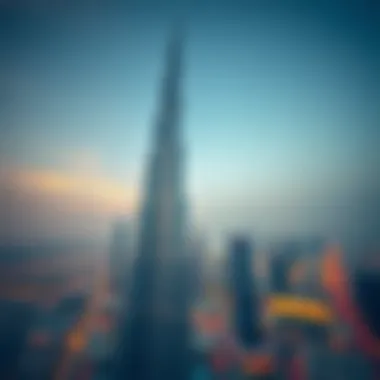
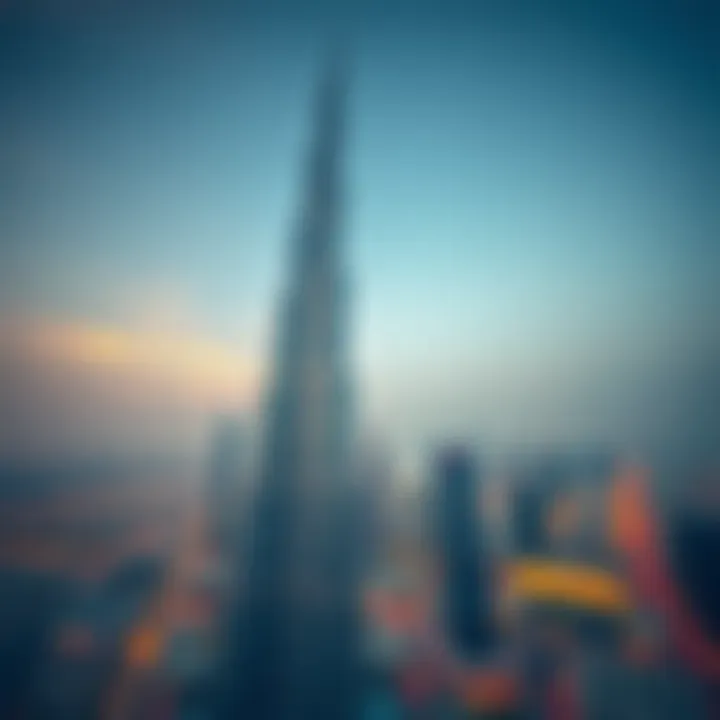
Burj Al Arab: The Iconic Hotel
The Burj Al Arab, often regarded as the epitome of luxury, is more than just a hotel; it's a landmark, a cultural representation of Dubai’s aspirations and an architectural masterpiece. Towering at 321 meters above the ground, this sail-shaped structure is frequently misidentified simply as a hotel. Its significance extends to its role in shaping Dubai's image as a global tourism destination, setting a high bar for what luxury can look like. With its unique shape, luxurious suites, and an array of amenities, this building truly stands as a beacon of what Dubai has achieved.
Architectural Features
When discussing the architectural features of the Burj Al Arab, one can't help but notice the design intricacies that make it stand out. The hotel is built on a man-made island, linked to the mainland by a private curving bridge. Its distinctive sail shape emulates the traditional dhows that have been central to the region's maritime history. Designed by Tom Wright of the architectural firm WS Atkins, each element of the structure integrates both form and function.
Here are some key features that highlight its architectural brilliance:
- Innovative Design: The Burj's unique shape not only provides an iconic silhouette against the Dubai skyline but also plays a strategic role in wind resistance, expertly designed to withstand the coastal winds.
- Luxurious Interiors: Inside, the hotel boasts opulent materials from around the globe, including Italian marble, gold leaf, and handcrafted fabrics. The attention to detail is unrelenting, with even the smallest corners showcasing luxury.
- Helipad: Located on the 28th floor, the helipad invites a never-ending stream of high-profile guests. It even hosted a game of tennis featuring Andre Agassi and Boris Becker, underscoring its avant-garde approach.
The Burj Al Arab is a testament to modern engineering and design. It pushes boundaries and sets new standards in hospitality and building aesthetics.
Tourism and Luxury Real Estate
The Burj Al Arab's impact on tourism cannot be overstated. It attracts visitors from all over the world who desire an unmatched experience. The allure of luxury is enhanced by its exclusive offerings, from personal butlers to world-class dining options.
It operates not just as a hotel but as a magnet for luxury real estate development in Dubai. Many travelers leave with a softened heart and a yearning to invest in a slice of the lifestyle they’ve tasted.
Some aspects that define its role in tourism and luxury real estate include:
- Symbol of Luxury: The hotel is often referred to as a 7-star hotel, a term not officially recognized but widely accepted. This branding itself has inflated Dubai’s status in global tourism.
- Real Estate Appeal: The proximity of Burj Al Arab to upscale neighborhoods has led to a boom in the luxury real estate market. Prospective buyers are often lured by the prestige associated with owning property near such an iconic landmark.
- Exclusive Experiences: From the underwater seafood restaurant to the sumptuous spa, every guest encounter ensures that the hotel’s reputation for opulence spreads wide. It sparks interest in luxury developments nearby, contributing to the overall growth of high-end real estate.
"The Burj Al Arab has not just set the standard; it has rewritten the rules on what luxury means in the realm of hospitality and urban living."
One Za'abeel: The Future of Vertical Living
Dubai’s skyline is not just about reaching for the clouds; it is a testament to innovation, aspiration, and the relentless pursuit of vertical living. One Za'abeel epitomizes this vision, representing not only an architectural marvel but also a movement towards more sustainable, efficient urban spaces. As the ambition for taller, smarter buildings persists, One Za'abeel stands as a beacon of what's possible in high-rise construction.
Innovative Design and Technology
One Za'abeel features an impressive blend of cutting-edge design and innovative technology. It is set to include the world’s highest occupied building and promises to redefine what is achievable in skyscraper engineering. Its design, crafted by the imaginative minds at Ace Architects, emphasizes unique verticality, allowing natural light to flow through its spaces, creating a delightful atmosphere for its occupants.
The building's structure is crafted using state-of-the-art materials that provide durability while minimizing weight. This is incredibly important as skyscrapers like One Za'abeel push the envelope in terms of height and stability. The core design is revolutionary, utilizing a central reinforced concrete core, enabling the building to withstand wind forces and provide residents with a sense of security amid the heights.
Moreover, the integration of smart technologies within One Za'abeel enhances not just efficiency but also the living experience itself. Climate-controlled environments, automated energy systems, and intelligent waste management setups are just a few features that underline its commitment to sustainability. The focus is on reducing the ecological footprint while providing luxurious amenities.
Implications for Dubai's Real Estate Market
The arrival of One Za'abeel is likely to stir significant ripples in Dubai’s already vibrant real estate market. With its avant-garde design and strategic location — near the business district — investors are likely to see One Za'abeel as a lucrative opportunity. As more people flock to Dubai seeking modern living spaces, the demand for high-rise dwellings is expected to soar.
"One Za'abeel is not merely about height; it’s about redefining urban living for the future."
The property will likely command premium prices, which could elevate the overall market landscape. For investors, this could represent a dual opportunity: not only to generate rental income but also to own a piece of architectural history. The property management of the building is set to provide a high level of service, enhancing its appeal to high-net-worth individuals.
In addition, One Za'abeel's development may push the boundaries for future projects, encouraging competitors to adopt similar innovative practices. The resultant effect could stimulate more investment in Dubai’s real estate sector, leading to a cycle of growth that benefits all stakeholders.
Overall, One Za'abeel epitomizes the future of vertical living, intertwining advanced technology, modern design, and strategic planning with the hope of evolving urban landscapes in Dubai. As Dubai continues to grow, buildings like this will play a crucial role in shaping not just its skyline, but also its identity on the global stage.
The Marina 101: A Modern Marvel
The Marina 101 stands as a testament to Dubai's continuous pursuit of architectural excellence and innovation. With its striking 101-story silhouette gracing the skyline of Dubai Marina, this skyscraper is not just a marvel for its height, but also for the layers of complexity involved in its construction and its subsequent allure to potential residents and investors. As one of the tallest buildings in the United Arab Emirates, it embodies a unique blend of modern design aesthetics while contributing significantly to the urban environment of Dubai.
Construction Challenges
Constructing Marina 101 was no small feat. Every inch of this towering structure posed challenges that tested the limits of engineering and ingenuity. The initial ground preparation needed meticulous planning due to the soft, sandy soil typical of the region, requiring advanced foundation techniques. To support the weight of such a tall building, contractors opted for deep piling, ensuring stability in both the short and long term. The integration of advanced construction technologies such as high-strength concrete and innovative scaffolding systems allowed builders to work efficiently, despite the extreme weather conditions typical of Dubai, particularly during the summer months.
Additionally, the high-rise demands intricate coordination among various teams, from architects to safety personnel, all needing to work in harmony. Navigating these challenges not only tested the limit of engineering capabilities but also set a precedent for future skyscraper projects in the region. Effective planning allowed the building’s completion in record time, showcasing the expertise and resilience of construction firms operating in such an ambitious environment.
Residential Appeal and Investment Opportunities


Marina 101's allure extends beyond its architectural significance; it presents appealing residential opportunities for investors and homebuyers alike. Its prime location positions it within the heart of Dubai Marina, offering panoramic views of the waterfront, ensuring a sense of tranquility juxtaposed with the hustle and bustle of city life. The luxurious amenities housed within the building, such as state-of-the-art fitness centers, infinity pools, and private lounges, cater to a high-end lifestyle that attracts affluent residents.
Investors particularly find Marina 101 an attractive prospect due to the consistent demand for residential properties in the area. With Dubai's real estate market showing signs of resilience, amid shifting global economic climates, the potential for capital appreciation in this towering gem is substantial. Short-term rental opportunities are abundant, driven by tourism and business travel, ensuring that investors see a steady stream of income.
- *"Investing in Marina 101 not only secures a piece of urban luxury but represents a stake in the future of Dubai's skyline."
As new developments spring up around Marina 101, including retail spaces and leisure facilities, the value of properties in the vicinity is expected to grow, making it an opportune time for savvy investors to dive in.
The Role of Skyscrapers in Urban Development
In Dubai, skyscrapers serve as more than mere architectural statements; they embody the aspirations and growth of this thriving city. Skyscrapers have a vital role in urban development, shaping how the city operates and interacts with its inhabitants. These towering structures facilitate a dense and dynamic urban environment, which in turn stimulates economic growth, enhances cultural identity, and improves overall quality of life for both residents and visitors.
Connection to Public Infrastructure
Skyscrapers often intersect almost seamlessly with public infrastructure, forming a backbone for efficient urban living. Tall buildings not only maximize the use of available land but also provide easy access to essential services like public transport, roads, and utilities. For example, in areas like Dubai Marina, the combination of high-rise residential buildings with well-planned road networks and Metro stations showcases how urban planning can integrate skyscrapers into the larger urban fabric.
- Accessibility: The placement of skyscrapers alongside public transportation hubs encourages more foot traffic and reduces reliance on private vehicles, helping ease congestion.
- Diverse Amenities: Skyscrapers frequently house commercial, residential, and recreational facilities, promoting a self-contained lifestyle where residents can find everything from restaurants to gyms and grocery stores within walking distance.
- Strategic Planning: The Emirate's initiative to zone land usage smartly reduces sprawl, allowing the city to maintain its aesthetic while promoting sustainable urban growth.
"Well-planned skyscraper development can transform cities into thriving economic centers, minimizing commute times and enhancing lifestyle convenience."
Influence on Neighborhood Dynamics
The presence of skyscrapers fundamentally alters the dynamics of neighborhood development. When a tall building rises, it acts as a catalyst for change within its vicinity.
- Increased Property Values: Skyscrapers can significantly elevate property values in the areas surrounding them. This surge in demand may lead to a wave of new constructions, further shaping community characteristics.
- Cultural Exchange: High-rise buildings often become focal points, attracting a mix of professionals, tourists, and residents. This blend enriches the local culture, generating a vibrant atmosphere where diverse communities can thrive together.
- Gentrification Effects: While new developments can uplift neighborhoods, they may also lead to gentrification, displacing long-term residents. The challenge then becomes balancing growth with cultural preservation, ensuring that the benefits of skyscraper construction are equitably shared.
As market demand continues to influence urban landscapes in Dubai, the role of skyscrapers will grow ever more significant.
This dynamic interplay between skyscrapers and urban development highlights the need for thoughtful planning and community engagement to ensure the lasting benefits of these architectural masterpieces.
Real Estate Investment Potential of Tall Buildings
The allure of skyscrapers in Dubai is not just a matter of aesthetics; they represent some of the most valuable real estate investments in the world. These towering structures offer more than just breathtaking views; they provide unique opportunities for those looking to invest in a dynamic market. Drawing attention from an international audience, the skyline boasts diverse residential spaces, modern offices, and luxury hotels, each contributing to the greater tapestry of Dubai's economy.
Given its strategic location, Dubai serves as a hub for business and tourism, thus enhancing the value of properties within its reach. Investors are increasingly eyeing tall buildings for their potential to deliver high returns and significant appreciation in value over time. The intricate designs and luxury amenities that these buildings offer are attractive to high-net-worth individuals, encouraging them to consider these spaces not merely as homes but as investments.
Furthermore, the impact of tall buildings on the community cannot be understated. They can stimulate local economies by attracting businesses and tourism while fostering a vibrant lifestyle for residents. With amenities ranging from shopping complexes to leisure facilities, these skyscrapers transform the areas around them, often resulting in increasing demand and property values.
Market Trends and Analysis
Keeping a close eye on market trends can provide insights into the real estate investment potential of tall buildings in Dubai. Recent years have seen a noticeable shift towards more sustainable and smart buildings, reflecting changing consumer preferences and global focus on sustainability. While luxury and unique architectural designs are still highly sought after, worldly investors are increasingly favoring buildings that incorporate energy-efficient technologies and promote eco-friendly living.
Several key factors currently shape the market trends in Dubai's skyscraper landscape:
- Increased Demand for Luxury Living: As income levels rise in the region, there is a growing interest in high-end residential spaces. Properties that offer top-notch amenities are particularly coveted.
- Foreign Investments: With the government promoting foreign ownership of real estate, many international investors are eager to snag prime spots within iconic buildings.
- Short-term Rentals: Everyday more investors are exploring short-term rental opportunities in tall buildings, ensuring continuous income flow.
These trends create a fascinating environment for analysis, as investors must remain vigilant in evaluating their options. The blend of luxury and sustainable living is likely to continue influencing preferences among prospective buyers.
Challenges and Risks of Investing
As much as there are opportunities, the potential for challenges and risks cannot be overlooked. Skyscrapers often come with high initial costs, both in purchasing and maintaining these properties. Investors face various obstacles that can impact profitability, including:
- Market Volatility: The real estate market can change hands quickly, with property values swinging due to economic downturns or oversupply in certain sectors.
- Regulatory Hurdles: Navigating the legal landscapes, such as ownership laws and property rights for foreigners, can be complicated.
- Maintenance Costs: The upkeep of high-rise buildings can be substantially higher than that of conventional properties due to the complexities involved with facilities, maintenance staff, and security measures.
Understanding these risks is crucial for investors looking to navigate Dubai's bustling market safely. Awareness of the ongoing trends and potential challenges can drastically improve decision-making processes.
In summary, while the potential rewards of investing in Dubai's tall buildings are significant, they come bundled with complexities that require careful consideration. An investor's success will largely hinge on their ability to analyze the market and recognize both the opportunities and pitfalls inherent in this vibrant sector.
Views and Outlook: Prospective Buyers and Investors
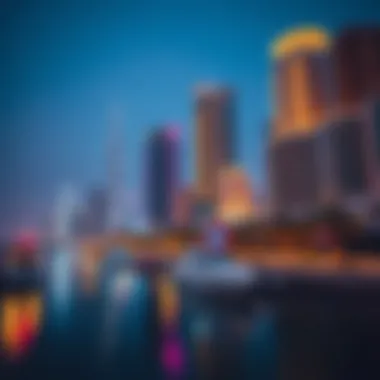

When it comes to understanding the allure of Dubai’s skyscrapers, the perspectives of potential buyers and investors cannot be understated. The dynamic landscape of the real estate market in this city is influenced by various factors, including the unique architecture of these tall buildings, the community around them, and the influx of international attention. Not only do these structures provide breathtaking views, but they also represent robust investment opportunities.
Navigating the Real Estate Market
The real estate market in Dubai can feel like a double-edged sword for buyers and investors. On one side, you have high demand fueled by the constant influx of expatriates and tourists eager to experience the luxurious lifestyle Dubai offers. On the flip side, the market can be somewhat elusive—understanding its trends, fluctuating prices, and investment potential is a challenge.
To navigate this complicated terrain, prospective buyers should consider the following:
- Research Local Market Trends: Keep an eye on property values in areas where skyscrapers dominate. Some neighborhoods may witness an increase in value due to new developments or amenities being introduced.
- Consult with Local Experts: Having a knowledgeable real estate agent who understands the nuances of the Dubai market can provide invaluable insights and help pinpoint ideal investment opportunities.
- Evaluate Property Management Services: Many tall buildings offer management services that can simplify the rental process. A well-managed property can enhance occupancy rates and return on investment.
"Understanding when to buy or sell can be the difference between profit and loss in Dubai’s fast-moving market."
Future Developments on the Horizon
The skyline of Dubai is ever-evolving, and this continuous development is a significant factor for both homebuyers and investors to consider. Several upcoming projects could reshape the real estate landscape even further. Investors should keep a keen eye on these developments, as they may provide attractive opportunities.
Some noteworthy future projects include:
- New Urban Developments: Planned communities nestled near existing skyscrapers that enhance urban living experiences while increasing property values.
- Smart Building Technologies: Buildings incorporating cutting-edge tech for sustainability. Properties that prioritize eco-friendly practices often attract a premium price due to growing demand based on environmental consciousness.
- Public Infrastructure Enhancements: Improvements in roads and public transport systems around tall buildings can boost accessibility, making properties in those areas winners in the investment game.
In summary, recognizing the importance of views and outlook in Dubai’s real estate market provides prospective buyers and investors with a clearer vision of what's to come. Understanding the trends, discerning future developments, and consulting local experts can significantly enhance the chances of making savvy investment decisions.
Sustainable Practices in Tall Building Construction
As the world progressively shifts toward a more environmentally conscious mindset, the sheer scale of construction projects—especially towering structures—has prompted the need for sustainable practices. Sustainable construction isn't just a passing trend; it’s a vital component of modern architectural design, particularly in urban areas like Dubai. In terms of tall buildings, sustainability offers a two-fold advantage: reducing environmental impact while enhancing the overall quality of life for residents and visitors alike.
The skyscrapers in Dubai often serve as more than mere architectural statements; they embody the notion of sustainability through their design, materials selection, and resource management. As an investor or homeowner, understanding these practices can influence decision-making and investment strategies.
Green Building Technologies
Dubai's tall buildings have increasingly embraced green building technologies, which often involve a slew of innovative designs and materials. These methods focus on energy efficiency, water conservation, and the use of sustainable materials.
- Energy-efficient Systems: Many skyscrapers in Dubai utilize advanced energy systems, such as solar panels and wind turbines, to supplement their power needs. For example, the Burj Khalifa employs a highly sophisticated system for climate control that minimizes energy consumption.
- Recycling and Reuse: Another notable approach is the inclusion of recycled materials in construction. Using recycled steel, concrete, and other materials reduces the demand for new resources and lowers the carbon footprint.
- Water conservation mechanisms: Low-flow fixtures and water recycling systems are increasingly common in Dubai's tall buildings. They not only reduce water waste but also contribute to the overall sustainability of the urban environment.
Impact on Environment and Urban Life
The repercussions of sustainable practices in building construction reach far beyond the structures themselves.
Environmental Impact: When skyscrapers integrate green technologies, they tend to lessen the strain they put on natural resources. The reduction in the carbon footprint helps mitigate the adverse effects of climate change and urbanization.
- Air Quality Improvement: For residents, improved air quality is a notable benefit of these practices. Green roofs and vertical gardens help to filter pollutants and produce oxygen, making urban living much more pleasant.
- Biodiversity Promotion: Some buildings are designed with habitats for local wildlife, effectively creating pockets of biodiversity amidst urban development.
Urban Life Quality: Ultimately, sustainable practices lead to a more livable city. The use of natural light, green spaces, and community areas in skyscrapers enhances the well-being of residents. Such environments can foster better mental health and a sense of community, which is invaluable in densely populated areas like Dubai.
"Incorporating sustainability in skyscraper construction not only reflects a commitment to the environment but also enhances the quality of life for its inhabitants."
Investing in sustainable buildings isn't merely about profits; it's about legacy. There's a growing expectation—especially among younger generations—that the urban infrastructure should cater to both human and environmental needs. As a result, potential buyers and investors in Dubai's real estate market should carefully consider how sustainability informs their decisions, prioritizing properties that align with these values.
Culmination: The Legacy of Skyscrapers in Dubai
Dubai's skyline tells a story unlike any other, a tale of ambition, cultural spirit, and architectural prowess. As we wrap up our exploration of the tall buildings that shape this vibrant city, it is crucial to reflect on their lasting legacy. The importance of these structures extends far beyond aesthetics. They signify a transformation not just in the skyline, but also in the economic and social fabrics of the region.
Architectural Identity of Dubai
Tall buildings are not merely structures; they form the architectural identity of Dubai. Each skyscraper contributes to a themed narrative within the city, creating a skyline that is both futuristic and rooted in rich tradition. The Burj Khalifa stands tall not just as the world’s tallest building but also as a beacon of what Dubai represents: prosperity, resilience, and innovation.
Notably, the fusion of traditional Islamic design with sustainable technologies is a hallmark of these structures. For instance, the use of wind turbines and solar panels in buildings like One Za'abeel showcases an approach that values both modernity and the environment. This delicate balance attracts and impresses homebuyers and investors alike.
"The skyscrapers of Dubai are symbols of architectural innovation, reflecting the city's aspirations toward greatness."
This architectural identity is not stagnant; it evolves to reflect contemporary society's values and needs. Developments such as Marina 101 and others incorporate aspects of community living and environmental consciousness that resonate with today's market demands.
Enduring Influence on Global Real Estate Trends
The skyscrapers of Dubai also exert immense influence over global real estate trends. As a city that continually pushes boundaries, Dubai's structures set benchmarks for luxury living, urban design, and aspiring heights of construction. Investors often look to Dubai as a litmus test for the viability of skyscrapers in other metropolitan areas.
Key trends emerging from Dubai include:
- Mixed-use developments: Incorporating residential, commercial, and recreational spaces in a single building not only addresses the demand for convenience but also enhances the value proposition for potential buyers.
- Sustainability: The increasing focus on green buildings is shaping values on a global scale, urging developers to adopt eco-friendly practices in their projects.
- Technology integration: Smart buildings equipped with advanced automation and security features are now becoming the norm, pushing other cities to follow suit.
The real estate market is sensitive to these shifts; as Dubai showcases its skyscraper innovations, it inspires investors to adapt and redefine their strategies worldwide. Homes and offices in the shadows of these magnificent towers are often viewed as prized possessions, reinforcing the idea that if you want to be at the heart of the action, you need to align with what Dubai represents.











